
|
Sale 30
Manuscript and Collectibles Auction
| Lot |
Photo |
Description |
Realized |
Lot 1715 |
 |
10½ Pound Dinosaur Coprolite. Dinosaur excrement is highly sought after both as a conversation piece and for study by a group of scientists called scatologists. This huge 6½ in. long x 4¼ in. wide x 5½ in. high, 10½ lb. specimen could only be from a dinosaur, since dinosaurs were the only really large animals populating the Morrison Formation near Garfield, Utah 150 million years ago. The specimen was originally larger, but it lost moisture and shrank during the fossilization process and about one fourth of it is missing on one end. The outer surface is a rust orange color while the interior is a mixture of browns and grays with flecks of orange. Also included is a polished 4½ x 2½ in. section to show the colors and patterns of the interior of the coprolite. The various colors are due to bacteria breaking down the organic compounds of the coprolite and mineralization of the fossilization process. Allow $35 for shipping.
Estimated Value $200 - 300.
View details and enlarged photo
| Unsold |
Lot 1716 |
 |
100 Million Year Old Fish With Smaller Fish In Its Stomach. Complete fossil fish are desirable, but finding one that still has the remains of its last meal in its stomach is extraordinary. Such is the case with this museum quality fossil of an 8½ in. long orange fish, Prionoleris, from Hajoula, Lebanon. Some of the most beautiful of all fossil fish come from the 100 million year old fossil beds of Lebanon. The contrast of the orange fish with the cream-colored limestone is dramatic. The 3¾ in. long tummy fish can be distinctly seen inverted with its head facing the tail of the larger fish. The head, eye and vertibrae are visible, having been swallowed whole, head first. Dramatic fish fossils such as this are usually only found in museums. Allow $20 for shipping.
Estimated Value $850 - 1,350.
View details and enlarged photo
| Realized
$1,150 |
Lot 1717 |
 |
100 Million-Year-Old Guitarfish & Herring-like Fish. The most desired fish fossils comes from the Cretacious period of Lebanon. They are so highly coveted because of their 100-year-old age, along with the detail and orange-brown color of preservation. This particular fossil limestone block contains both the rare Guitarfish Rhinobatis, as well as a herring-like fish, Pseudoberyx. The rare 7½ in. long Guitarfish is nearly complete and is entirely cartilaginous, as is every relative of sharks and rays. The eyes, nose, tail and some rays are defined. The smaller 6 in. herring-like fish, Pseudoberyx, is also nearly complete, with ribs and fins and missing just the front tip of thehead.
Different species of fish found in combination are very rare as fossils. All fossil rays are rare in the fossil record, due to their delicate bone structure. For domestic shipping, add $25.
Estimated Value $850 - 1,400.
View details and enlarged photo
| Unsold |
Lot 1718 |
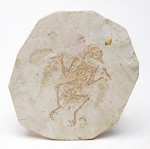 |
140 Million Year Old Bird Fossil From China. Some of the oldest birds in the fossil records have been found in the Liaoning province of China. This small 4¼ in. primitive bird, Liaoxiornis delicatus, dates from the late Jurassic period. Only Archaeopterix from Germany is older at 150 years. This virtually complete bird is remarkable in the details of its preservation. Birds have light, delicate bones that rarrely fossilize at all. Due to an enormous volcanic eruption 140 million years ago, this bird was killed by the gases and quickly buried in volcanic ash, thus preserving it intact. Today this delicate fossil is still preserved in the fragile, compacted volcanic ash that has turned to stone. Most specimens are cracked and broken, but this one is intact and has not been repaired, leaving very delicate and faint impressions available for study. There are some black feather impressions surrounding the body and wings, as well as a darker, tan wing outline clearly visible on the lighter tan matrix. The important single claws at the ends of the wings are present, as well as the curved foot claws and skull, missing only the tip of the beak. Displayed and protected in an 8¾ x 6½ in. Ryker mount. Allow $25 for shipping.
Estimated Value $1,850 - 2,750.
View details and enlarged photo
| Realized
$1,553 |
Lot 1719 |
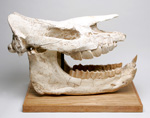 |
15 Million Year Old Rhino Skull From China. This huge, virtually complete skull comes from a very strange-looking early rhino (Chilotherium) found in Fugu, Shanxi Province of China. The upper skull measures 19½ x 8½ in. and has been professionally prepared out of its original limestone matrix. The white bone quality is excellent, with some dark brown matrix still attached for stability. There are twelve large teeth in the skull, the largest being 1½ x 2 in. To complete the display, a cast of the lower jaw was carefully prepared from another similar-sized specimen found with this one. The perfectly matched, cast lower jaw has twelve teeth, the largest being 1¾ x 1½ in., along with two 2 in. "tusks"--two teeth which protrude from the lower jaw.
Chilotherium was a very large, early rhino that looked somewhat like a cross between a rhino and a hippo. It had a barrel-shaped body with short legs like a hippo and may have been aquatic like a hippo, but had a very rhino-like face and head, with two weird knob-shaped horns made out of hair (they usually don't fossilize) and two tusk teeth in the bottom jaw. An impressively mounted, huge fossil skull, free standing on a custom wood base. Allow $125 for shipping.
Estimated Value $3,500 - 5,000.
View details and enlarged photo
| Unsold |
Lot 1720 |
 |
150 Million Year Old Aquatic Reptile From China. This new and unusual reptile, Sinohydrosaurus lingyaunensisgen, lived in fresh water and was buried in an enormous volcanic eruption 150 million years ago in Liaoning Province, China. Nearly complete at 13 inches, this specimen is missing only a few digits on one of the back feet and a few tail vertebrae. The bone is a medium brown color on a light, soft-stone matrix. The delicate claws and their ribs are well defined. The matrix measures 19 x 8 in. Sinohydrosaurus may be related to Nothosaurs, such as Keichosaurus, or Lepidosaurus, of which the Komodo Dragon is a member. Allow $40 for shipping.
Estimated Value $700 - 1,250.
View details and enlarged photo
| Realized
$575 |
Lot 1721 |
 |
210 Million Year Old Complete Pine Cone & Petrified Wood Section. Two items from Patagonia, Argentina: (1) A large 2½ x 2¼ in. pine cone that has been cut in half and polished to show the excellent internal detail of the lindividual seeds and center core. The interior has beautiful orange, pink, and tan colors. (2) A polished, colorful section of petrified wood from the Araucaria tree from which the pine cone fell. It is 4 x 3¼ in. in various shades of tan, brown, and pink. For domestic shipping, add $20.
Estimated Value $450 - 600.
View details and enlarged photo
| Realized
$380 |
Lot 1722 |
 |
240-Million-Year-Old Keichousaurus, Guizhou Province, China. At over 11 inches in length, this Keichousaurus is one of the larger examples of this type of aquatic animal. the bones are black and rest on a tan matrix. The last 3 inches of the tail are at about 90 degrees to the rest of the tail. This probably occurred during the fossilization process as the skin and muscle deteriorated, and the tail being bent as it came to rest on its matrix. Keichousaurus was the ancestor of the long-necked Plesiosaurs, of which the reports of the Loch Ness monster seem to fit. This specimen is complete with various fractures to the matrix professionally sealed. A wonderful display piece. For domestic shipping, add $30.
Estimated Value $1,200 - 1,600.
View details and enlarged photo
| Realized
$1,093 |
Lot 1723 |
 |
255 Million Year Old Gymnosperm Plant From Australia. Glossopteris browniana was a strange type of tree known as Pteridospermale, and only grew in the Southern Hemisphere. This very colorful 14 x 8 inch slab contains at least nine leaves plus several partials, the largest being 4 inches long and ranging in color from yellow to brown to reddish brown. The quality of the leaves is extraordinary with tiny vein detain visible. A most attractive and large specimen of one of the strange early trees of the late Permian Period. Found in the Illawarra Coal, Dunedoo, North S.W. Australia. Also several more leaves and parts are visible on the bottom side of the slab. For domestic shipping, add $30.
Estimated Value $350 - 600.
View details and enlarged photo
| Unsold |
Lot 1724 |
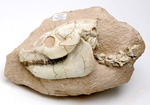 |
30 Million Year Old Pig/Camel-like Animal. Leptaucheria was a strange early mammal that was an ancestor of both pigs and camels. It had some features that are found in both. It was a scarce type of mammal that may have been an aquatic swimmer or a tree climber; nobody knows for sure. Whatever it is, this is a nearly complete 5¾ x 3½ in. skull missing only a tiny tip of the nose, but with 32 brown enamel teeth and even 2½ in. of neck vertibrae, which are rarely found with the skulls. The glossy brown enamel teeth contrast nicely with the lighter tan skull. The 3-D skull and vertebrae are still partially embedded in the limestone as found. The 9 x 6 x 5 in. stone nodule has been neatly sculpted to make a dramatic display. An important museum-quality fossil from the White River Badlands of South Dakota. Allow $30 for shipping.
Estimated Value $1,000 - 1,500.
View details and enlarged photo
| Unsold |
Lot 1725 |
 |
8 Inch Cave Bear Penis Bone and 4 Inch Canine Tooth. Cave bears were the largest of all bears, standing more than 10 feet tall. They did not need Viagra since they possessed a penis bone called a Baculum. This 8 in long, ¾ in. thick Baculum is a lovely brown color, complete except for a very small chip on the tip. Also included is a 4 in. long canine tooth of Ursus spelaeus; the tooth is 1¼ in. with a near complete 2¾ in. root. These cave bear fossils are 20,000 to 100,000 years old and were found in Rumania. Ursus spelaeus roamed throughout Europe at this time. Allow $20 for shipping.
Estimated Value $200 - 325.
View details and enlarged photo
| Realized
$115 |
Lot 1726 |
 |
Book-end Sized Block of Crinoids and Stems From Morocco. Crinoids are called sea lillies because they resemble a plant but are actually related to starfish with their five-fold symmetry. This large 8 x 7 inch block has crinoid crowns and stems on one side and stems on the other. Somethimes a group of crinoids were buried together as a result of a 410-million-year-old disaster such as a mud slide. That is the case with this remarkable specimen which has one side filled with partial crinoid crowns of the species Scyphocrinites with their delicate feeding arms with pinnules, comb-like filtering nets to capture micro organisms. the other side of the block is filled with spring-like crinoid stems. This well-prepared fossil has been expertly prepared to stand upright and could be used as a book-end or just as an impressive display piece. For domestic shipping, add $20.
Estimated Value $350 - 600.
View details and enlarged photo
| Unsold |
Lot 1727 |
 |
Carcharodontosaurus saharicus Tooth, 4½ Inches Long. Size does matter in dinosaur teeth. Even though Carcharodontosaurus saharicus was larger than a T-Rex, most of the teeth found are only 1½-2½ inches long. This magnificent brown tooth has most of its enamel present, with only slight cracks, which are nearly always present. Its sharp serrations are nearly complete on both sides of the tooth. This shed tooth would be more than one foot long if its root were still attached. Carcharondontosaurus teeth are found in the Sahara desert, Morocco, and are older than T-Rex at 70-80 million years old. The tooth is housed in a 4½ x 5½ in. Ryker mount. A tooth this size with a perfect tip is usually seen only in a museum. Allow $20 for shipping.
Estimated Value $900 - 1,400.
View details and enlarged photo
| Unsold |
Lot 1728 |
 |
Cave Bear Hand and Foot Paws with Claws. Ursus spelaeus, Cave Bear, was the largest bear that ever lived. It has been extinct for only 10,000 years. These hand and foot claws are between 20,000 and 150,000 years old and were found in caves in Romania. The hand is 10 in. long and 6 in. wide and mounted with wires. The bone is light brown, complete with all five claws, measuring up to 1.5 in. in length. The claws would have been larger in life, covered with keratin such as we have in our fingernails. The matching foot is 11 in. long and 5 in. wide and mounted with wires. It has brown bones and all the claws. This pair matches perfectly with similar color and size. An outstanding specimen for display or study. Allow $35 for shipping.
Estimated Value $650 - 900.
View details and enlarged photo
| Realized
$1,035 |
Lot 1729 |
 |
Collection of Five Amber With Insect Inclusions. Insects in amber have been in great demand ever since the movie Jurassic Park. Some of the largest and most beautiful pieces of amber have come from the rain forests of Columbia. Their exact age cannot be determined directly, but their color and hardness suggest that they are at least 1-5 million years old. The size of these very clear amber nuggets varies from 1¾ in. to 4 in. in length. Only the 4 in. nugget has not been polished on all sides; one side has been left as found to allow the termites to be viewed more easily in contrast. The other four very clear golden-colored nuggets contain flies, fleas, ants, beetles, termites, fungus, a small twig, parts of leaves, etc. The more that these amber nuggets are examined with a magnifying glass, the more insects are found, with incredible detail. In a 8¼ x 6¼ in. Ryker mount. Allow $15 for shipping.
Estimated Value $250 - 375.
View details and enlarged photo
| Realized
$219 |
Lot 1730 |
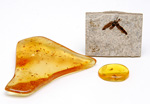 |
Collection of Three Different Fly Fossils From China, Poland & Colombia. An interesting and varied collection of flies from 1-110 million years old. Three pieces: (1) ¾ in. Fly, open wings on small limestone matrix. 110 million years old, from Liaoning Province, China. (2) 40-50 million-year-old fly in amber from Poland. The fly is perfectly preserved with incredible ____ detail, head and eyes in a ¾ in. clear amber nugget. (3) 1-5 million-year-old group of small flies in a beautiful 2½ x 1½ in. honey-colored amber from a Colombian rain forest. For domestic shipping, add $15.
Estimated Value $275 - 375.
View details and enlarged photo
| Realized
$161 |
Lot 1731 |
 |
Collection of Two, 100-Year-Old Insects. These amazingly-detailed insects are from the Santana Formation in Chapado do Araripe, Brazil and are over 100 million years old. The rarely-found 3/8 in. long spider may actually have bitten a dinosaur. The spiders' eight legs, as well as two eyes, are preserved and are focused straight out of the sandstone matrix. the large, 1 in. long brown cricket has intricate detail, including the small spines on the legs. These crickets would have been a favorite food of small dinosaurs. Both fossils are housed in an 8½ x 6½ in. Ryker mount. For domestic shipping, add $15.
Estimated Value $450 - 650.
View details and enlarged photo
| Realized
$288 |
Lot 1732 |
 |
Complete Curved Mammoth Tusk From Siberia - Nearly 4 Feet Long. From Mammuthis pricmigenics. Complete Mammoth tusks are rare, but large, 4-feet-long tusks (47 x 5 in.) that show the characteristic double curve of an adult Mammoth are much rarer. This polished tusk reveals beautiful colors of green, brown cream and tan which were caused by the mineralization of the white ivory with vivianite and iron phosphate. This museum-quality tusk was found on the Taymyr Penninsula of Siberia and is between 50,000 and 100,000 years old. Because it is long and relatively slender (5 in. in diameter), it probably belonged to an adult female Mammoth. This spectacular tusk comes with an oak display stand. It is by far the best and largest we have ever handled. Similar specimens have brought over $10,000 at natural history auctions. For domestic shipping, add $150.
Estimated Value $4,000 - 9,000.
View details and enlarged photo
| Realized
$3,450 |
Lot 1733 |
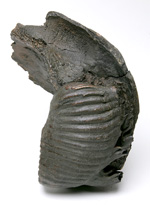 |
Complete Mammoth Tooth With Roots, In A Partial Mandible. This complete, near perfect mammoth tooth is 7 x 5½ in. and is still set in a portion of the lower jaw (mandible). Woolly mammoths roamed over the northern hemisphere and became extinct less than 20,000 years ago. This spectacular tooth, with its roots intact and exposed in the inner jaw, is more than 80,000 years old. It was found in a rare area for fossils: San Fluss, Poland. The appealing brown bone is in near perfect condition, showing even the minute internal structure. The back of the mandible has been cut away to reveal the detail of the complete roots. This is a museum-quality specimen.
Estimated Value $500 - 850.
View details and enlarged photo
| Unsold |
Lot 1734 |
 |
Complete Psitaccosaurus Dinosaur, 127 Million Years Old. All of the bones from this important dinosaur were removed from their 127 million year old rocky tomb and professionally mounted in a life-like running position. Some of the excellent-quality bones are fused together with rods in the middle to give the skeleton a natural appearance without wire braces and frames. This dramatic Psittacosaurus skeleton is 36 in. long with more than 85% real bone, unlike most museum dinosaurs which usually are casts or 15-25% original. The only restored bones are at the end of the tail, neural spines and a few hard bones.
The 4 x 5 in. skull is excellent with the important Jugals (extension of the jaw bones) plus fenestrae (openings at the back of the skull that define Psittacosaurus as the most ancient of Ceratopsians -- hormed dinosaurs). Psittacosaurus did not have horns like its more famous relative, Triceratops. This magnificent dinosaur is so well preserved because it was buried in volcanic ash from a gigantic eruption 127 million years ago in Liaoning Province, China. Psittacosaurus (translates to "parrot beaked reptile") is so very imporant as the smallest "horned" dinosaur that eventually became some of the most bizarre dinosaurs at the end of the Cretaceous period.
In recent news, also in Liaoning Province, a baby Psittaccosaurus was found in the stomach of the remains of a Mesozoic, dog-sized mammal, the first evidence scientists had that some triconodont mammals were carnivorous and fed on small vertebrates, including young dinosaurs.
This is a rare opportunity to acquire a museum-mounted dinosaur. The skull and all four limbs are easy to remove for study and then put back in the mount for a unique, table-top display. A similar, slightly-larger specimen brought over $58,000 in a recent Natural History auction.
Allow $550 for crating and shipping.
Estimated Value $13,000 - 20,000.
View details and enlarged photo
| Realized
$16,100 |
Lot 1735 |
 |
Duck bill Dinosaur Egg From Henan Province, China. This fully prepared airbrushed chocolate brown egg is 7 in. long, 6 in. wide, and 5 in. high. It is a complete, unhatched egg with excellent shell quality, having only a minimal repair of a crack runs along the top of the egg and a couple of small pieces of eggshell glued into place on one side. The egg sits attractively on a shaped section of the natural red sandstone base. The 70-80 million year old egg was found by farmers from the Xixia Henan Province of China. The exact species of dinosaur cannot be determined from just an egg, but this oblong shape has been determined to be from a duckbilled dinosaur, since ducbilled dinosaur bones have been found in the area such nests. Such a hadrosaur duckbilled dinosaur is Shantungosaurus that has been found in the same area as the eggs and was one of the largest hadrosaurs at more than 50 feet long. Allow $35 for shipping.
Estimated Value $500 - 800.
View details and enlarged photo
| Unsold |
Lot 1736 |
 |
Giant 13 x 10 Inch Colorful Fossil Turtle. From the White River Badlands of Wyoming, this famous turtle (Stylemys nebraseensis) is more than 25 million years old and is virtually complete, missing only a 1½ x 1 inch piece of shell, and with a complete plastron (the underside of the turtle). What makes it so desirable is both its large size (normally found only 6-9 inches) and its attrractive, light brown color, instead of the usual white color that blends with the matrix. This turtle looks as if it is ready to pop its head out and crawl away. A fantastic, museum-quality specimen. For domestic shipping, add $35.
Estimated Value $800 - 1,200.
View details and enlarged photo
| Realized
$690 |
Lot 1737 |
 |
Gigantic Mammoth Tooth - Over 13 Inches. Mammoths had the laergest teeth of any animal that ever lived and this 13 inch+ tooth is one of the largest found. It is a complete, museum-quality, dark-brown tooth with its roots still intact. Normally, the roots are broken and mostly missing. This most impressive mammoth tooth is 80,000 years old from a rare area for fossils (San Fluss, Poland). Mammoths used the large flat surface of their teeth to grind vegetation. The dark, brown-gray sections are made of enamel and the light-brown areas in between the enamel are made of dentine. An unbelievable display specimen, certain to amaze. For domestic shipping, add $30.
Estimated Value $600 - 1,000.
View details and enlarged photo
| Realized
$575 |
Lot 1738 |
 |
Huge 100-Million-Year-Old Cartilaginous Fish, Rhinobatus. Some of the most beautiful fossil fish come from the early Cretaceous period of Lebanon. Most of these fossils are only 2-4 inches long, This huge 18½ in. Guitarfish is the exception. Rhinobatus was a cartilaginous fish related to sharks. This impressive fossil is essentially complete, with two-toned, light brown and darker brown cartilaginous bones and rays on a contrasting lighter tan matrix. The two small dorsal fins are present, as well as the tooth pavement with some teeth extending outwards from both sides of the tooth pavement, which extends back from the tip of the "snout" back towards the eyes. Rhinobatus was a bottom dweller and is well centered on its limestone 21½ x 5¼ inch sea-bottom slab. A rare, impressive, and displayable fossil. For domestice shipping, add $45.
Estimated Value $1,200 - 1,600.
View details and enlarged photo
| Unsold |
Lot 1739 |
 |
Huge 5¼ Inch Shark's Tooth. Carcharodon megalodon is known only from its teeth, but what teeth they are! This huge 5¼ in. long tooth (measured along the diagonal) was from a very large shark, at least 50-60 feet long. The tooth has dark tan enamel with a dark brown root. The serrations are in good condition with only a tiny chip on one side. Carcharodon teeth are sometimes found in the muddy bottom of the Morgan River of South Carolina. Weighing more than eight times as much as the great white shark of "JAWS," this whale-hunting shark must have been truly terrifying when it cruised the oceans 15 million years ago.
Estimated Value $375 - 500.
View details and enlarged photo
| Realized
$414 |
Lot 1740 |
 |
Huge Museum Quality Tyrannosaurus Egg. Huge 16 x 8 in. Tyrannosaurus bataar dinosaur egg. This is the best quality Tyrannosaurus egg available, with over 95% of the original shell present. The Raitite (bird-like markings), are clearly shown on the shell. This exquisitely detailed raised pattern is usually very worn on other specimens. The dark brown egg is somewhat flattened, a result nearly always encountered from the delicate egg being compressed from being buried and covered by tons of rock over time. Tyrannosaurus eggs are by far the largest and rarest of all dinosaur eggs. This is because Tyrannosaurus did not travel in herds like many other dinosaurs, and they laid their eggs in isolated areas. Tyrannosaurus bataar is a close cousin of the T-Rex of North America; however, no T-Rex egg has ever been found. A rare opportunity to acquire a museum quality Tyrannosaurus egg. Allow $60 for shipping.
Estimated Value $3,000 - 4,000.
View details and enlarged photo
| Realized
$2,760 |
Lot 1741 |
 |
Large Patch of Woolly Mammoth Hair. This exceedingly rare specimen of mammoth hair consists of both types of hair present: the long reddish-brown outer hair, as well as the soft tan inner hair. There is over ten times as much hair in this lot as is normally offered. More than 30,000 years old, this remarkable specimen comes from the frozen carcass of one of only 12 Woolly Mammoths found frozen in the permafrost of the Indigirka Basin in Siberia. This specimen was part of the collection owned by Dr. Gennady Baryshnikov, head of the History of Faunas Department, Zoological Institute, USSR Academy of Sciences in Leningrad. For domestic shipping, add $15.
Estimated Value $500 - 800.
View details and enlarged photo
| Realized
$334 |
Lot 1742 |
 |
Near Complete Mesosaurus Sleleton - 260 Million Years Old. This excellent fossil of a 25 inch long marine reptile is both visually impressive, being nearly complete, and important for the information imparted by its geographical distribution. First of all, this small aquatic reptile was the very first known reptile to return to the sea 260 million years ago, shortly after evolving from amphibians, but even more importantly, it helps prove the theory of continental drift: It is found only on the western part of South Africa and the eastern part of South America.
This near-complete skeleton of Mesosaurus is from the Irati Formation of Brazil. The attractive brown bone is most notable in showing detail of the crocodile-like skull, including several small sharp teeth, each tooth in its own socket. The tail is complete except for the very end of the tip, which is rare in this type of fossil. Only the four limbs and feet are either missing or disarticulated. This impressive pre-dinosaur reptile is in its natural 20 x 10 inch limestone matrix. Allow $30 for shipping.
Estimated Value $1,500 - 2,200.
View details and enlarged photo
| Realized
$1,150 |
Lot 1743 |
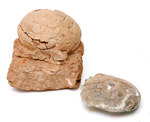 |
Pair of Therizinosaurus Eggs. Therizinosaurs were the most bizarre and unusual dinosaurs. They appear to have been a plant-eating theropod related to the raptors. Therizinosaurs walked bipodally with the body, long neck, and small head of a plant-eating dinosaur, but with up to two-feet claws on their hands. What they used the large claws for is unknown.
This lot contains a 4 in. unhatched egg with over 85% of its original shell still in its red limestone matrix, as well as a 3½ in. unhatched, crushed egg that has calcified. The importance of such calcification is that embryonic bones have been found in 5-10% of calcified eggs. The only way to know for sure is to slowly etch the egg to expose any fragile bones. Both eggs are 65-70 million years old, from the Xixia Basin, Henan Provinc of China. Allow $30 for shipping.
Estimated Value $500 - 900.
View details and enlarged photo
| Unsold |
Lot 1744 |
 |
Partial Lower Jaw of Triceratops With Two Partial Teeth. Jaws of all dinosaurs are rare. This 65-70-million-year-old right maxilla section is 4½ x 3½ in. and contains two small .6 in. and .4 in. parts of teeth. The size of the teeth indicates that this lower jaw section belonged to a juvenile Triceratops. the bone is a dark brown color with excellent micro detail, including a series of channels where the teeth would stack up, one on top of the other, forming an impressive tooth battery that would enable the Triceratops to replace its teeth as they wore down. Found in the Hell Creek Formation of Harding County, South Dakota, this is an important dinosaur bone in understanding dinosaur eating apparatus. For domestic shipping, add $20.
Estimated Value $500 - 800.
View details and enlarged photo
| Unsold |
Lot 1745 |
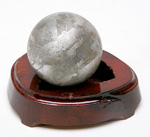 |
Polished and Etched Campo del Ciel Sphere - 6¼ Inches. Etched iron-nickel meteorite spheres are highly sought after by both meteorite collectors and collectors of mineral spheres. This 6¼ inch, 477 gram Campo del Cielo sphere looks like a strange planet with light and dark patterns. The difference in the etch pattern results from two different alloys of nickel which have separated from each other by the asteroid core cooling slowly over millions of years. Campo del Cielo meteorites fell 3000-5000 years ago in Chaco, Argentina. They are very difficult to cut because of many silicate and graphite inclusion s which break the cutting lathes. This valuable meteorite comes with a wooden stand for display. For domestic shipping, add $20.
Estimated Value $550 - 750.
View details and enlarged photo
| Realized
$748 |
Lot 1746 |
 |
Premium Quality Set of All Three Types of Meteorites. There are three different types of meteorites and this remarkable lot has three specimens hand-selected by a meteorite collector to represent all three types with exceptional specimens: (1) Stony Meteorite Dhofa 316, a 2¾ x 2¼ in. polished and etched section weighing 61 gms, dark brown interspersed with light grey areas. This Ordinary Chondrite was found Dec. 21, 2001 in the Sahara desert of Oman. (2) Sikhote-Alin Iron-Nicket Meteorite, a 3 x 1 in. cut-and-polished section with original fusion crust all the way around the periphery. This famous meteorite fell on Feb. 12, 1947 above the Sikhote-Alin mountains of Siberia. (3) Brahin Pallasite, 1¾ x 1½ in. section weighing 21 gms from the rarest of all meteorites: the Pallasites. These are a mixture of iron-nickel and olivine originating from the core-mantle boundary of a blasted-apart large asteroid. Thir thinly-sliced superior specimen clearly shows the gem-stone quality of the green-yellow olivine when held up to a light. For domestic shipping, add $20.
Estimated Value $500 - 750.
View details and enlarged photo
| Realized
$431 |
Lot 1747 |
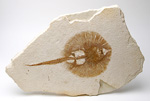 |
Rare 12 Inch-Long, Fat-Tailed Stingray. Stingrays are among the rarest and most beautiful of all the Green River, Wyoming fossils. Stingrays rarely fossilize because, like sharks, their skeletons are cartilaginous. This museum-quality, 12-inch long fossil preserves the very tiny bones of the "wings," the complete tail with its stingers, and even its toothplate with its tiny shell-crushing teeth. Toothplates rarely show because the stingray needs to be buried upside down for the teeth to show. As an added bonus, this is a rare species of stingray that has a wider tail than the usual variety, Heliobatis radians. Thousands of fossil fish are found each year in the Green River fossil lakebed, but only two or three stingrays.
Estimated Value $2,500 - 3,500.
View details and enlarged photo
| Realized
$1,955 |
Lot 1748 |
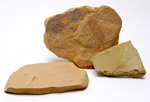 |
Rare Collection of the First Multicelled Animals - Early Cambrian Period. At over 535 million years, the amazing soft-bodied fossils of Chengjang, China are the earliest fossils of animal life in the fossil record. Before the beginning of the Cambrian 543 million years ago, all of the ancestors of animals were microscopic in size. These exotic Chingjang creatures were also small and mostly soft bodied, but remarkable preserved in fine-grained limestone. Making them even more desirable is the fact that the other famous Cambrian fossil site, the Burgess Shale, has been closed to collecting for 50 years.
This varied collection includes: (1) A huge 1¼ in. (huge for early Cambrian) Isopyxparadoxos, which was a bivalved orthopod with its entire body enclosed within the carapace. (2) ¾ in. Hyolithid, which was a straight mollusk-like animal with one of the first shells. The animals had tentacles but what they were is still unknnown. (3) ½ in. Long Leancholia in a side view which clearly shows its segmented body and head shield. These weird arthopods were blind and used long, whip-like appendages to sense their environment. Displayed in a Ryker mount for easy removal. For domestic shipping, add $20.
Estimated Value $600 - 800.
View details and enlarged photo
| Realized
$444 |
Lot 1749 |
 |
Rare Juvenile Triceratops Brow Horn - 5 Inches High. Triceratops is one of the most famous dinosaurs with its distinctive horns. Triceratops was one of the largest horned dinosaurs, known as ceratopsians. This lovely, chocolate-brown horn is 5 in. high and 2 in. wide, with some expert restoration on the tip, as is nearly always the case. The detail of the bone is excellent, with the furrows where blood flowed between the bony core and keraton covering, as well as microscopic holes in the bone, which helped keep the weight down. As this was a young Triceratops, there are more of the holes and a fine network of lines, indicative of fast growth. This 65-70 million-year-old fossil from one of the last dinosaurs was recovered from the Hell Creek formation in Harding Country, South Dakota. For domestic shipping, add $20.
Estimated Value $900 - 1,500.
View details and enlarged photo
| Unsold |
Lot 1750 |
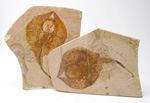 |
Rare Positive and Negative Fossil Stingray, 50 Million Years Old. Stingrays (Heliobatis radians) are among the rarest and most beautiful of all the fossils from Green River, Wyoming. Most of these stingrays occur as a single fossil, but rarely is one slab split open to reveal both a positive (with bones) and negative (counterpart) of the delicate fossil. This nearly complete 9 in. stingray is a perfect example of such splitting. Only about 1 inch at the front of the rays has been restored. Stingrays are cartilagenous like sharks and do not have a solid bone skeleton. The positive half of the ray has the very tiny bones of the "wing" and the complete tail with some of the tiny black tail vertebrae scattered around the tail. The negative half contains the complete body outline and some tail vertebrae, as well as the complete stingers. This is a rare opportunity to purchase two fossil slabs that both illustrate the fossil process and contain a rare and interesting fossil ray. Allow $35 for shipping.
Estimated Value $1,000 - 2,000.
View details and enlarged photo
| Realized
$575 |
Lot 1751 |
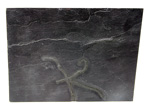 |
Six-Inch-Long, 375-Million-Old Starfish. Even though starfish are common, they rarely fossilize intact. The most famous ancient starfish fossils come from the lower Devonian (375 million years old) period of bundenbach, Germany. Interestingly enough, starfish have not changed much over the last 375 million years. This large 6 inch-long starfish (Urasterella) is nearly complete, missing just the tip of one of the five arms. One of the arms is short, but this isn't a defect in the fossil; rather, one of the arms of the starfish was lost and was regenerating when the starfish was fossilized. There is excellent detail on the starfish with the small plates visible atop each of the arms. Bundenbach slate is used for roofing, sometimes revealing fossils on roofed buildings that are 100-200 years old. With this site closed to collecting, only old collection specimens such as this lovely starfish are available to new collectors. For domestic shipping, add $25.
Estimated Value $500 - 700.
View details and enlarged photo
| Unsold |
Lot 1752 |
 |
Spectacular Seven Egg Duckbill Dinosaur Nest. Dinosaur eggs are in great demand and the supply of eggs from China has almost completely dried up. Original nests of dinosaur eggs are especially rare. This nest of 5 x 4½ in. dark brown eggs is 70-80 million years old, from a duckbill-type dinosaur from Henan Province, China. The eggs are completely original and are as excavated with 60-90% of the original shell still intact. The unhatched eggs are still in the same position on the same red limestone matrix where they were deposited by the mother duckbill dinosaur. The entire nest measures 15 x 13 in. and makes a truly dramatic display. Allow $75 for shipping.
Estimated Value $2,750 - 4,000.
View details and enlarged photo
| Realized
$2,645 |
Lot 1753 |
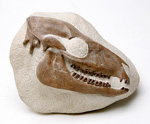 |
Spectacular Three-Toed Horse Skull. Eight-inch Skull of a Primitive, 30-Million-Year-Old Horse. There are few early horse fossils, even though they are some of the most popular of early mammal fossils. Like most animals, horses started out very small and gradually grew larger and lost toes over time. This museum quality, 8 x 5 inch dark brown skull is still aesthetically positioned in its original stone matrix and contains 20 brown-enameled teeth. Mesohippus was about four feet long, the size of a large dog and was able to trot and run on its three-toes feet; the center toe was longer than the other two. The teeth are wonderfully preserved in this specimen. This impressive skull was found in the White River Badlands of Nebraska and makes for an impressive display piece. For domestic shipping, add $25.
Estimated Value $2,500 - 3,750.
View details and enlarged photo
| Realized
$1,610 |
Lot 1754 |
 |
Super Crocodile Skull, 33 Inches Long, 45-70 Million Years Old. Dryosaurus phosphaticus, from the phosphate mines of Morocco. Sharks teeth from this location are common, but crocodiles are not. This spectacular skull is a wonderful, creamy white color on a brown, sandstone base. As an extra bonus, there are ten one-inch-long sharp teeth on one side of the jaw, as well as a couple of teeth and sockets on the other side. The crocodile skull is surprisingly slender, tapering down from a 10-inch-wide head to a 2-inch-wide snout with its two nostrils visible at the tip. The lower jaw is not present, but the skull rests flat on its limestone base for an outstanding and dramatic display. This sea-going crocodile would have been over 15 feet long. For domestic shipping, add $250.
Estimated Value $1,500 - 2,500.
View details and enlarged photo
| Unsold |
Lot 1755 |
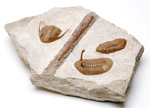 |
Three Different Trilobites and A Nautiloid. Trilobites were one of the first animals to develop eyes, more than 500 million years ago. They then became one of the most successful animals in the ocean until becoming extinct 250 million years ago. Partial pieces of the hardened shell of these early relatives of insects and horseshoe crabs are common, but complete detailed specimens are not.
Some of the most life-like and spectacular of trilobites come from the 450 million year old Wolchow River Basin southwest of St. Petersburg, Russia. This extraordinary limestone block contains three complete, lovely, light-brown trilobites, as well as a 5 in. Nautiloid, an early relative of the still-existing Chambered Nautilus. The most fascinating trilobite is the 2 in. long Neoasaphis kavalewski with its 1 in. long eyestalks resembling some strange kind of alien life form. Also present is a 2½ in. long Subasaphus platyurus, which has shorter eyestalks and wing-like long genal spines extending down both sides of its body. Last is a "plain" 2½ in. Asaphus with smaller eyes and no spines. All four fossils are attractively displayed on a 10½ x 9 in. limestone rock that entombed them for over 450 million years.
Estimated Value $850 - 1,250.
View details and enlarged photo
| Realized
$633 |
Lot 1756 |
 |
Three Morococan Trilobites. Trilobites were one of the very first animals with eyes over 500 million years ago. They were the dominant and most numerous sea creature of their day until supplanted by fish and crustaceans eons later. This premium quality collection of spiny and odd-shaped trilobites comes from the 400-480 million-year-old seas of Morocco: (1) Pair of unusual 480-million-year-old trilobites, Omnia superba, on the same rocky matrix noted for its bulbous nose (glabella) and bead-like ornamentation around its head shield and long, genal spines which was used for protection and to right itself if turned over on the sea bottom. (2) Dicranurus - a 400 million-year-old spiny trilobite with its distinctive Ram's horny-shaped spines above its head - 3 inchs long, complete except for some pieces missing on the tops of the "brows." (3) Harpes 1 3/8 inch black trilobite known as the "starship bug" because its strange-shaped head shield and spines make it look somewhat like a space ship. Most dramatically displayed on an expertly-prepared, light-gray matrix. For domestic shipping, add $20.
Estimated Value $600 - 1,000.
View details and enlarged photo
| Realized
$345 |
Lot 1757 |
 |
Two Trilobites, One A Complete Spiny "Ram's Horn" Trilobite. Trilobites are an extinct arthropod most closely related to horseshoe crabs. They come in all shapes and sizes, but the most highly-desired specimens are the spiny types which have sharp defensive spines to protect themselves from being swallowed whold by fish and large worms. Dicranurus is 400 million years old, found near Alnif, Morocco. It is defined by its large curved head spines which somewhat resemble "ram's horns." This Dicranurus is 2½ in. long, complete with perfect, black, curved horns and is facing a smaller 1¼ in. trilobite of more usual shape. both trilobites are aesthetically positioned on their natural tan stone base. For domestic shipping, add $15.
Estimated Value $350 - 500.
View details and enlarged photo
| Realized
$228 |
Lot 1758 |
 |
Type Set of Three Different Dinosaur Eggs. This interesting lot contains three very different dinosaur eggs from China 70-100 million years old (late Cretaceous period), that are becoming quite difficult to locate:
1. Oviraptor egg: 6½ x 3 in. oblong egg made famous by the mother Oviraptor sitting on a nest of these eggs. Embryonic bones were found in a very small number of these eggs, confirming that they belong to the bird-like theropod, Oviraptor. About 60% of the ratite black shell is visible on the top of the egg. The bottom of the egg contains no shell, but does have shell impressions.
2. 80 million year old duckbilled dinosaur egg, 6 x 5 in with about 50% of the original egg shell. The shell that is present on this attractive egg has been air brushed to a medium brown color. There is shell present on all sides of the egg.
3. 70 million year old Therizinosaur egg, 4 x 2¼ in. with 80% of the original egg shell, which has been airbrushed to reveal its unusual gray color. Therizinosaurs were the most bizarre of dinosaurs. They were bipedal with two-foot-long claws like a theropod and the long neck and small head of a plant-eating dinosaur.
Estimated Value $1,000 - 1,700.
View details and enlarged photo
| Realized
$1,150 |
Lot 1759 |
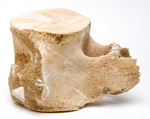 |
Whale Back Vertabrae With Great White Shark's Tooth. Of highest value to fossil collectors are fossils that give clues as to which animals preyed on other animals and how the prey might have died. This spectacular fossil is the result of a Great White Shark attack on a large whale 2-5 million years ago in Wingate Bay, California. Great White sharks are rare today and probably were rare millions of years ago, as their teeth are rarely found in the fossil record. This beautiful 1¾ in. creamy white tooth is complete with sharp serrations and root and is embedded in the upper portion of a large 10 x 6½ in. section of a whale 's back vertebrae. Even though the species of whale cannot be positively identified, it was quite large. The Great White shark (Carcharodon slucidens) that feasted on the whale was some 15-20 feet in length. Allow $25 for shipping.
Estimated Value $450 - 675.
View details and enlarged photo
| Unsold |
Lot 1760 |
 |
24 Pound Iron-Nicket Meteorite With Rare Natural Hole. This large 9½ in. long x 7 in. high x 6 in. deep new Campo del Cielo iron-nicket meteorite is not only an aesthetically-sculpted meteorte, but it also has a 1 in x ¾ in. natural hole near its bottom base. Holes in iron-nickel meteorites form only rarely when a particularly large inclusion completely burns and melts away during the brief time the large meteorite passes through the earth's atmosphere. Such natural holes are highly valued by meteorite collectors, but rarely offered for sale. Campo del Cielo translates as "Valley of the Sky"; it fell over 4000 years ago in Argentina. Spanish explorers were told of these valuable chunks of iron and wrote about them in 1576. This large, impressive meteorite has everything you would look for in an iron-nicket meteorite: a natural hole, regmaglypts (thumbprints) and shape. Allow $45 for shipping.
Estimated Value $2,500 - 3,500.
View details and enlarged photo
| Realized
$2,300 |
Lot 1761 |
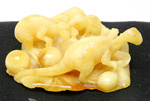 |
3 D Maiasaura Egg Nest Carved In Baltic Amber. 2½ x 2½ in. sculpture carved out of a single piece of 40 million year old Baltic amber. This spectacular piece consists of a maiasaura mother with three offspring, including one baby that has just hatched. There are four unhatched eggs in the nest, along with three hatched eggs. Maiasaura was a cretaceous duckbilled dinosaur found in the Rocky Mountains. Old amber is difficult to carve because it is so brittle. A spectacular piece with many individual details such as claws. Allow $15 for shipping.
Estimated Value $350 - 500.
View details and enlarged photo
| Realized
$322 |
Lot 1762 |
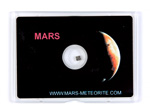 |
An Authenticated Piece of Mars. With all the attention that Mars has been receiving lately, one of the most desired collectibles is a section of a Martian meteorite. This is the only way to touch the Red Planet. Many times more valuable than diamonds, Martian meteorites are among the most exotic substances on earth. As with the moon meteorites, only very large impacts on the Martian surface are powerful enough to eject rocks out of the Martian atmosphere and after several million years, a very few will make their way to earth. Such a meteorite is DAG 476. It was found in the Libyan desert in May 1998. The 2 kg stony meteorite was authenticated as being a Shergottite, Martian meteorite, based on its ratio of oxygen isotopes and other characteristics. This 3mm x 2mm section is in a Ryker mount for protection and is accompanied by a Certificate of Authenticity. Allow $12 for shipping.
Estimated Value $250 - 500.
View details and enlarged photo
| Unsold |
Lot 1763 |
 |
An Authenticated Piece of the Moon. The only collectible pieces of the moon come from a handful of lunar meteorites that have found their way to the earth. It takes a large impact by an asteroid on the lunar surface to propel chunks of the moon into space, with only a very few of these surviving entry through earth's atmosphere. Dhofar 461 is one of these, found in the Sahara desert in Oman on April 22, 2001. Not much bigger than a pebble, it weighed only 33.72 gms, just over 1 ounce. Dhofar 461 is classified as an Anorthositic Crystalline Melt Breccia, which means that it came from volcanic rock from the surface of the moon. This 2mm x 2mm section wass cut and polished to reveal its dark gray color with many small inclusions. Placed in a Ryker mount for protection, this specimen is accompanied by a Certificate of Authenticity. Just a sample of moon dust, weighing only a few milligrams, sold at a 1993 auction for $42,500. Allow $12 for shipping.
Estimated Value $250 - 500.
View details and enlarged photo
| Unsold |
Lot 1764 |
 |
Large Hand-axe from the Homo heidelbergensis Culture. This classic-shaped stone hand-axe is from the Acheulean and between 150,000 to 300,000 years old. It is larger than most at 7 x 3¼ inches and has a lovely brown patina as found on the best of the hand-axes from the Western Sahara Desert. The lustrous brown color is known as desert varnish from the many thousands of years of being sand blasted. Homo heidelbergensis was an archaic Homo species that may have been one of our ancestors. Hand-axes were used to cut meat as well as for defense. For domestic shipping, add $15.
Estimated Value $275 - 450.
View details and enlarged photo
| Realized
$230 |
|
|